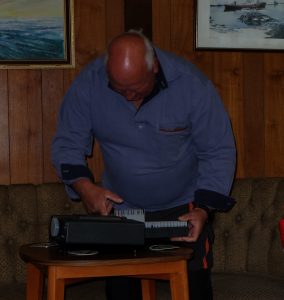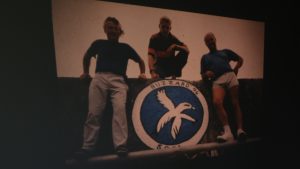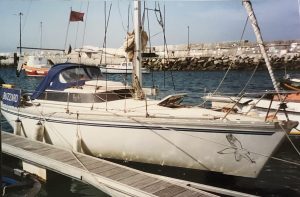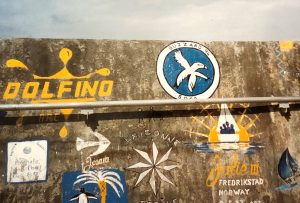 The May SOCA meeting was a retro style presentation given by Stewart Warren, using 20th Century slides (taken at the time) and a borrowed slide projector, about his 1994 ocean passage from Cape St Vincent, the south-western-most point of Portugal and of mainland Europe to Porto Santo, Madeira and Tenerife.
The May SOCA meeting was a retro style presentation given by Stewart Warren, using 20th Century slides (taken at the time) and a borrowed slide projector, about his 1994 ocean passage from Cape St Vincent, the south-western-most point of Portugal and of mainland Europe to Porto Santo, Madeira and Tenerife. Three men in a 27ft Jeanneau Fantasia named Buzzard for six weeks in the Atlantic Ocean.
One of many passages that Buzzard and various crews enjoyed on Jonesy’s journey to Venezuela.
Buzzard owner Stuart Jones (Jonesy), Johnathon Bentley and Stewart Warren started the trip by flying to Faro Portugal. Below is a picture (taken from the Slide Show) of them at Portot Santo,
 The following is the log of the journey as narrated by Stewart.
The following is the log of the journey as narrated by Stewart.“We took a rickety train to Lagos where Buzzard was moored in a creek off Ribeira de Bensafrim. Buzzard had been sailed here from the UK by Jonesy and another group of SOCA members. Neglected for a few months she was in quite a mess so we set about preparing her for the ocean passage. Lagos is a nice town so we enjoyed down time looking around and drinks in the Irish bars. We then had to provision for food, water and beer. All items had to be unpacked and checked for cockroaches and other infestations before loading onboard.
North Atlantic Destination Porto Santo Distance 575 nm
The North Atlantic first leg would be around 5 days at sea, I was seasick for the first day and a half in the rough seas, Atlantic rollers, waves on rollers, waves on waves. The Walkers Log measured speed and distance travelled as it spun on a line off the stern. These mechanical logs have now been superseded by electronic equipment and GPS navigation but they may make a return if the Russians scramble the GPS satellites. We soon got into a routine of cleaning and maintaining the boat. Night watches were 3hrs for each crew, alternating rota every night.
You know land is there but you don’t see it until it’s around 10 miles away. The camera came out at first sight of land, slide film so limited photos available, 24 exposures, 36 was too expensive. For those that didn’t know the answer to our recent quiz question the Yellow Duster was raised. a yellow flag, designating the letter Q International Code of Signals: flown by itself to signify that a ship has no disease on board and requests a pratique, or flown with another flag to signify that there is disease on board ship.
This was hoisted below the Portuguese courtesy flag at the starboard spreader.
Porto Santo
Marina de Porto Santo is located on the South coast of Porto Santo Island, inside the commercial harbour.  The Marina had 140 berths on floating pontoons. 11km long and 6km wide, Porto Santo has a wonderful 9km long natural sandy beach. Promoted as the Golden Island to the many tourists from Portugal and europe. We took a walk to town to hop at the market and also visited a “pension house“. We enjoyed a few glasses of wine in the elderly woman’s front room, dark and dingy but cheaper than a bar.
The Marina had 140 berths on floating pontoons. 11km long and 6km wide, Porto Santo has a wonderful 9km long natural sandy beach. Promoted as the Golden Island to the many tourists from Portugal and europe. We took a walk to town to hop at the market and also visited a “pension house“. We enjoyed a few glasses of wine in the elderly woman’s front room, dark and dingy but cheaper than a bar.
 The Marina had 140 berths on floating pontoons. 11km long and 6km wide, Porto Santo has a wonderful 9km long natural sandy beach. Promoted as the Golden Island to the many tourists from Portugal and europe. We took a walk to town to hop at the market and also visited a “pension house“. We enjoyed a few glasses of wine in the elderly woman’s front room, dark and dingy but cheaper than a bar.
The Marina had 140 berths on floating pontoons. 11km long and 6km wide, Porto Santo has a wonderful 9km long natural sandy beach. Promoted as the Golden Island to the many tourists from Portugal and europe. We took a walk to town to hop at the market and also visited a “pension house“. We enjoyed a few glasses of wine in the elderly woman’s front room, dark and dingy but cheaper than a bar.We took part in an age old tradition to make a mark of passage. The island is a crossroads in world navigation and passing yachts make their mark on the harbour wall by leaving a mural depicting their crew, boat and future intentions.

Porto Santo to port Funchal, Madeira Distance 72 nm
This second leg had much calmer seas. We set the sails, two headsails goose-winged and cruised the distance in a day sail. Calmer seas allowed for fishing, whale watching – Pilot whales and even making use of the solar shower. Madeira slowly became visible on the horizon. Approaching the island we saw turtles, wildlife-watching speedboat trips are popular tourist activities in Funchal.
Madeira
Funchal Port was historically a stopover for large ships during their passages between Europe and the American and African continents. Now, besides being an important trading place, it is particularly known for welcoming tourists on the many cruise ships which stop enroute to other destinations.
The SS Canberra Ocean liner was in port. She had been Operating on cruises, in the P&O fleet since 1961 and while we were there was offloading passengers from the “bluerinse” ferries. She was also well know as her services in the Falklands War where she had served as a troop ship. As opposed to being mechanically coupled with her propeller shafts, as was the standard when she was built, her steam turbines drove large electric alternators which powered electric motors and in turn drove the ship’s propellers. This was the most powerful steam turbo-electric propulsion system ever installed on a ship and gave her a speed of approximately 27 knots.
We took a stroll around the traditional boat building along the beaches. The three then scoured the taxi rank for a reasonably priced tour of the island, we asked to see the real island not tourist areas. He took us up to the forested area at the peak, formal gardens, traditional houses and fish farm. We had lunch at a roadside truck stop full of locals. We finished our tour at the Monte sledge, a very famous attraction, with cars made of wicker and wood which are scooted down the steep streets. The three men enjoyed beers in the local bars and presented the local Irish bar with a soca burgee.
Funchal to Tenerife Distance 330 nm
Departing Madiera, the wind steering was excellent, we set the blade and the rudder was fixed keeping a very good course. We should have made the distance in three days but we were virtually becalmed and were unsure as to how the diesel would last. We were again getting into the routing of whale watching, cleaning, checking the yacht for wear and tear, solar showers, more whales.
Approaching the Tenerife coast the sea was flat calm with white horses in the distance. We reefed down and in an instant hit a maelstrom, the acceleration zone between Tenerife and La Gomera. The cockpit filled, wash boards went in but at least it was warm water up to our knees. It ended as quick as it started and we could raise the yellow duster, this time under the Spanish courtesy flag, and enjoy the sail up the coast with the whale watchers and pilot whales.
Tenerife
Entering Puerto Colón marina we saw lots of activity with jolly boats and tourist fishing boats. The modern marina is located in the south of Tenerife, just 16 kilometers from the Reina Sofia Airport. Nestled in Playa de las Américas, one of the busiest tourist areas of the island.
Sport fishing for shark is big business in Tenerife. We took the tour bus up to Mount Teide the volcano, It’s summit is the highest point above sea level in the islands of the Atlantic. We enjoyed chicken roasted over a volcanic vent at the restaurant. The three men could only get single seats from Reina Sofia Airport so after a week relaxing in Tenerife one by one they headed back to the uk. I was last to leave the yacht Buzzard at the Marina, Jonesy would return in a few weeks to move her to La Gomera.”
